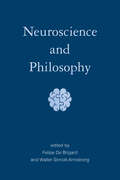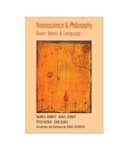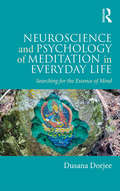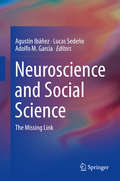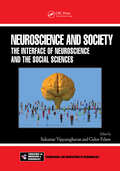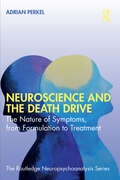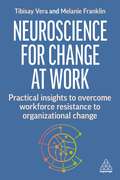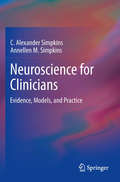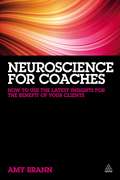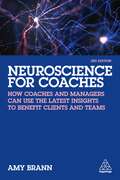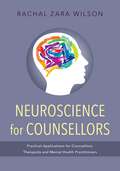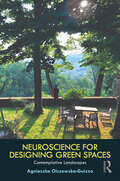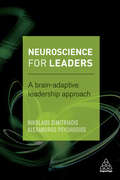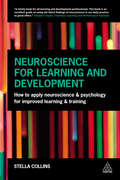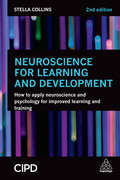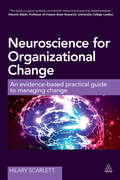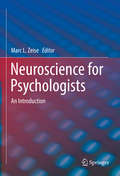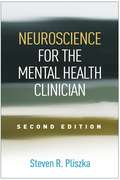- Table View
- List View
Neuroscience and Critique: Exploring the Limits of the Neurological Turn
by Ed Pluth Jan De VosRecent years have seen a rapid growth in neuroscientific research, and an expansion beyond basic research to incorporate elements of the arts, humanities and social sciences. It has been suggested that the neurosciences will bring about major transformations in the understanding of ourselves, our culture and our society. In academia one finds debates within psychology, philosophy and literature about the implications of developments within the neurosciences, and the emerging fields of educational neuroscience, neuro-economics, and neuro-aesthetics also bear witness to a 'neurological turn' which is currently taking place. Neuroscience and Critique is a ground-breaking edited collection which reflects on the impact of neuroscience in contemporary social science and the humanities. It is the first book to consider possibilities for a critique of the theories, practices, and implications of contemporary neuroscience. Bringing together leading scholars from several disciplines, the contributors draw upon a range of perspectives, including cognitive neuroscience, critical philosophy, psychoanalysis, and feminism, and also critically examine several key ideas in contemporary neuroscience, including: The idea of "neural personhood" Theories of emotion in affective neuroscience Empathy, intersubjectivity and the notion of "embodied simulation" The concept of an "emo-rational" actor within neuro-economics. The volume will stimulate further debate in the emerging field of interdisciplinary studies in neuroscience, and will appeal to researchers and advanced students in a range of disciplines including critical psychology, philosophy, and critical studies.
Neuroscience and Education: A Philosophical Appraisal (Routledge International Studies in the Philosophy of Education)
by Clarence W. JoldersmaThis volume makes a philosophical contribution to the application of neuroscience in education. It frames neuroscience research in novel ways around educational conceptualizing and practices, while also taking a critical look at conceptual problems in neuroeducation and at the economic reasons driving the mind-brain education movement. It offers alternative approaches for situating neuroscience in educational research and practice, including non-reductionist models drawing from Dewey and phenomenological philosophers such as Martin Heidegger and Merleau-Ponty. The volume gathers together an international bevy of leading philosophers of education who are in a unique position to contribute conceptually rich and theoretically framed insight on these new developments. The essays form an emerging dialogue to be used within philosophy of education as well as neuroeducation, educational psychology, teacher education and curriculum studies.
Neuroscience and Philosophy
by Felipe De Brigard and Walter Sinnott-ArmstrongPhilosophers and neuroscientists address central issues in both fields, including morality, action, mental illness, consciousness, perception, and memory. Philosophers and neuroscientists grapple with the same profound questions involving consciousness, perception, behavior, and moral judgment, but only recently have the two disciplines begun to work together. This volume offers fourteen original chapters that address these issues, each written by a team that includes at least one philosopher and one neuroscientist who integrate disciplinary perspectives and reflect the latest research in both fields. Topics include morality, empathy, agency, the self, mental illness, neuroprediction, optogenetics, pain, vision, consciousness, memory, concepts, mind wandering, and the neural basis of psychological categories. The chapters first address basic issues about our social and moral lives: how we decide to act and ought to act toward each other, how we understand each other&’s mental states and selves, and how we deal with pressing social problems regarding crime and mental or brain health. The following chapters consider basic issues about our mental lives: how we classify and recall what we experience, how we see and feel objects in the world, how we ponder plans and alternatives, and how our brains make us conscious and create specific mental states.
Neuroscience and Philosophy: Brain, Mind, and Language
by Peter Hacker Daniel Dennett John Searle Maxwell BennettIn Neuroscience and Philosophy, three prominent philosophers and a leading neuroscientist clash over the conceptual presuppositions of cognitive neuroscience. The book begins with an excerpt from Maxwell Bennett and Peter Hacker's Philosophical Foundations of Neuroscience (Blackwell, 2003), which questions the conceptual commitments of cognitive neuroscientists. Their position is then criticized by Daniel Dennett and John Searle, two philosophers who have written extensively on the subject, and Bennett and Hacker in turn respond. Their impassioned debate encompasses a wide range of central themes: the nature of consciousness, the bearer and location of psychological attributes, the intelligibility of so-called brain maps and representations, the notion of qualia, the coherence of the notion of an intentional stance, and the relationships between mind, brain, and body. Clearly argued and thoroughly engaging, the authors present fundamentally different conceptions of philosophical method, cognitive-neuroscientific explanation, and human nature, and their exchange will appeal to anyone interested in the relation of mind to brain, of psychology to neuroscience, of causal to rational explanation, and of consciousness to self-consciousness.In his conclusion Daniel Robinson (member of the philosophy faculty at Oxford University and Distinguished Professor Emeritus at Georgetown University) explains why this confrontation is so crucial to the understanding of neuroscientific research. The project of cognitive neuroscience, he asserts, depends on the incorporation of human nature into the framework of science itself. In Robinson's estimation, Dennett and Searle fail to support this undertaking; Bennett and Hacker suggest that the project itself might be based on a conceptual mistake. Exciting and challenging, Neuroscience and Philosophy is an exceptional introduction to the philosophical problems raised by cognitive neuroscience.
Neuroscience and Psychology of Meditation in Everyday Life: Searching for the Essence of Mind
by Dusana DorjeeNeuroscience and Psychology of Meditation in Everyday Life addresses essential and timely questions about the research and practice of meditation as a path to realization of human potential for health and well-being. Balancing practical content and scientific theory, the book discusses long-term effects of six meditation practices: mindfulness, compassion, visualization-based meditation techniques, dream yoga, insight-based meditation and abiding in the existential ground of experience. Each chapter provides advice on how to embed these techniques into everyday activities, together with considerations about underlying changes in the mind and brain based on latest research evidence. This book is essential reading for professionals applying meditation-based techniques in their work and researchers in the emerging field of contemplative science. The book will also be of value to practitioners of meditation seeking to further their practice and understand associated changes in the mind and brain.
Neuroscience and Social Science
by Agustín Ibáñez Lucas Sedeño Adolfo M. GarcíaThis book seeks to build bridges between neuroscience and social science empirical researchers and theorists working around the world, integrating perspectives from both fields, separating real from spurious divides between them and delineating new challenges for future investigation. Since its inception in the early 2000s, multilevel social neuroscience has dramatically reshaped our understanding of the affective and cultural dimensions of neurocognition. Thanks to its explanatory pluralism, this field has moved beyond long standing dichotomies and reductionisms, offering a neurobiological perspective on topics classically monopolized by non-scientific traditions, such as consciousness, subjectivity, and intersubjectivity. Moreover, it has forged new paths for dialogue with disciplines which directly address societal dynamics, such as economics, law, education, public policy making and sociology. At the same time, beyond internal changes in the field of neuroscience, new problems emerge in the dialogue with other disciplines.Neuroscience and Social Science – The Missing Link puts together contributions by experts interested in the convergences, divergences, and controversies across these fields. The volume presents empirical studies on the interplay between relevant levels of inquiry (neural, psychological, social), chapters rooted in specific scholarly traditions (neuroscience, sociology, philosophy of science, public policy making), as well as proposals of new theoretical foundations to enhance the rapprochement in question.By putting neuroscientists and social scientists face to face, the book promotes new reflections on this much needed marriage while opening opportunities for social neuroscience to plunge from the laboratory into the core of social life. This transdisciplinary approach makes Neuroscience and Social Science – The Missing Link an important resource for students, teachers, and researchers interested in the social dimension of human mind working in different fields, such as social neuroscience, social sciences, cognitive science, psychology, behavioral science, linguistics, and philosophy.
Neuroscience and Society: The Interface of Neuroscience and the Social Sciences (Frontiers in Neuroscience)
by Sukumar Vijayaraghavan Gidon FelsenAdvances in neuroscience research are rapidly redefining what it means to be human. The absence of the brain/mind dichotomy has, in turn, removed the separation between our brain biology and our sociocultural experiences, raising questions for social sciences to address. How responsible are we, as individuals, for our actions? Do we have free will? Is it ethical for us to peer into others’ brains? How are our collective social cultural norms influenced by our brain function? At the same time, neuroscientists need to develop better intuition about the ethical, legal, and social implications of their research. Close collaboration between neuroscience and social sciences is the best way forward.This book acts as an introduction to these and other issues that lie at the interface of neuroscience and social sciences, using the physiological underpinnings of our decision-making processes as a framework. Examples of topics addressed here are: Neuroscience and economics Neuroscience and law Neuroscience and ethics Neuroscience and mental health Neuroscience of religion and humour The book is intended for students of neuroscience and social sciences, as well as readers generally interested in the human condition. It is hoped that the book will stimulate cross-disciplinary thinking and inspire a new generation of thinkers who are willing to look at both social sciences and neuroscience research with a different lens. Such bridge builders will be the pioneers of the next level of interrogation at this emerging interface.
Neuroscience and the Death Drive: The Nature of Symptoms, from Formulation to Treatment (The Routledge Neuropsychoanalysis Series)
by Adrian PerkelIn this book, Adrian Perkel seeks to expand upon Freud’s theory of the death drive by locating it within modern neuroscience, arguing for the centrality of the aggressive drive in the formation of mind, and the genesis of symptoms and psychopathology. Neuroscience and the Death Drive reformulates the function of defence mechanisms as they link to the aggressive drive and their role in the binding of free energy. Filling an important gap in both formulation and treatment, this book completes Freud’s self-confessed incomplete theory of aggression through the lens of modern psychoanalysis and neuroscience, updating these concepts with current scientific insights, and introduces a refreshed view on psychotherapeutic treatment implications based on these developments. Perkel explores the treatment of patients experiencing eating disorders, anxiety, depression, addiction, personality disorders and sexual dysfunction. This invigorating and approachable book will be of interest to all psychoanalysts, psychiatrists, psychotherapists and counsellors, and will help readers reach new understandings of this key theory of the mind.
Neuroscience for Change at Work: Practical Insights to Overcome Workforce Resistance to Organizational Change
by Melanie Franklin Tibisay VeraHow do I communicate change to the business? How do I maintain productivity and wellbeing during change? How do I deal with resistance to business change?Neuroscience for Change at Work answers these questions and explains how to use insights from neuroscience when designing change and communicating it to employees. It is based on the PEPE model which outlines the four fundamental principles that drive resistance to change in individuals, teams and the wider organization. This book provides specific coverage of how neuroscience can inform change initiatives in remote, hybrid and in-person working environments to ensure successful business transformation in any working model. There is also discussion of how change can impact employee mental health and wellbeing and explains how using insights from neuroscience can help to safeguard this. There is also discussion of how to handle competing priorities from different groups of employees during times of business change. Every chapter of Neuroscience for Change at Work is supported by practical examples, tips, tools and case studies as well as robust, evidence-based insights from neuroscience. Co-authored by a neuroscientist with extensive experience in applying neuroscience to business transformation projects, this book is a practical guide for all change managers and anyone responsible for employee engagement, wellbeing and productivity during times of change.
Neuroscience for Clinicians
by C. Alexander Simpkins Annellen M. SimpkinsThis book fills the need for an introductory text that opens the field up to the beginner and takes them to higher-level thinking about neuroscience. Neuroscience has captured the interest of students, professionals, and the general public. In fact it is so new, that there are very few books that gather it together in one text. Neuroscience is an amalgamation of many fields: psychology, cognitive science, chemistry, biology, engineering, philosophy, mathematics, and statistics. People who are new to the discipline have to be able to find their way through all of these fields together. In addition, they need to understand the highly technical lexicon, modeling methods, and theoretical assumptions used to describe brain structure, function, and the interaction between them. This book helps readers navigate the conventions used to describe the brain that developed through the years. The authors crystallize the complex modeling methods and technologies so that readers understand what they are saying and how to use them. They address the important underlying principles and important issues of neuroscience, with the debates and discussions that are ongoing as the field evolves. They also include many salient fine-grained details so that the book is not just an overview, but also a useful guide for many levels of readers.
Neuroscience for Coaches
by Amy BrannThe world of coaching is competitive. Organisations want coaches who deliver results, and can prove it. Many coaching tools and techniques are now fairly well established - but how do they actually work? The coach who can answer this question credibly and convincingly is sought after. This ground-breaking book equips coaches with cutting edge neuroscience information that will help them deliver greater value to their clients. It covers the foundations that coaches need to be aware of and crucially, the ways they can use this new information effectively and practically in their everyday work. Readers will strengthen their kitbag of coaching tools and will be able to explain to their clients the neurological underpinning of the techniques they are using. No forward-thinking coach can afford to be ignorant of recent scientific developments: Neuroscience for Coaches will give them the practical knowledge they need.
Neuroscience for Coaches: How coaches and managers can use the latest insights to benefit clients and teams
by Amy BrannMany coaching tools and techniques are now well established, but how do they actually work? The third edition of Neuroscience for Coaches answers this question to help coaches and managers deliver greater value to clients and employees.Based on extensive research, Neuroscience for Coaches provides a clear explanation of the aspects of neuroscience that are relevant to coaching so coaches can describe to clients why particular techniques work and the benefits to be gained from using them. It also features interviews with Marshall Goldsmith, Susan Grandfield, Christian van Nieuwerburgh and Kim Morgan on topics including mindfulness and behaviour change in coaching.This fully updated third edition covers the latest neuroscientific research on key brain areas and their functions, such as the Prefrontal cortex and Amygdala which affect attention, processing and emotional regulation. With tips and insights throughout, it crucially demonstrates the ways in which coaches and managers who coach can use this information effectively and practically in their everyday work. Neuroscience for Coaches is a vital resource for improving coaching practice with the latest scientific developments, tools and techniques.
Neuroscience for Coaches: How to Use the Latest Insights for the Benefit of Your Clients
by Amy BrannMany coaching tools and techniques are now fairly well established, but how do they actually work? Neuroscience for Coaches equips coaches with information that will help them answer this question and therefore deliver greater value to clients. Based on over twelve years of research, this book provides a clear explanation of the aspects of neuroscience that are relevant to coaching so you can describe to clients from a neuroscientific perspective why particular techniques and methods work and the benefits to them.This fully updated 2nd edition of Neuroscience for Coaches includes new interviews with Marshall Goldsmith, Susan Greenfield, Christian van Nieuwerburgh and Kim Morgan, along with new material on oxytocin, goals and mindfulness. It covers the latest neuroscientific research and, crucially, the ways in which coaches can use this information effectively and practically in their everyday work. Neuroscience for Coaches is a vital resource for keeping up to date with recent scientific developments, tools and techniques in coaching.
Neuroscience for Counsellors: Practical Applications for Counsellors, Therapists and Mental Health Practitioners
by Rachal Zara WilsonThis is an invaluable resource for counsellors and therapists looking to reinvigorate their practice and enhance their understanding of clients' needs. Each chapter focuses on different discoveries in neuroscience, explains them in plain English and provides guidance on how to put this knowledge to practical use in the therapy room. It covers specific psychological and neurological diagnoses including bipolar affective disorder, eating disorders and ADHD, as well as other more general issues such as attachment and addiction. The book also contains recommendations backed by evidence from neuroscience for optimum mental health involving nutrition, sleep and exercise, and a comprehensive glossary of technical terms. Presenting the practical applications of neuroscience, this book will be of immeasurable use to counsellors, psychotherapists and psychologists, and also of interest to social workers and mental health practitioners.
Neuroscience for Designing Green Spaces: Contemplative Landscapes
by Agnieszka Olszewska-GuizzoUrban parks and gardens are where people go to reconnect with nature and destress. But do they all provide the same benefits or are some better than others? What specific attributes set some green spaces apart? Can we objectively measure their impact on mental health and well-being? If so, how do we use this evidence to guide the design of mentally healthy cities? The Contemplative Landscape Model unveils the path to answer these questions. Rooted in landscape architecture and neuroscience, this innovative concept is described for the first time in an extended format, offering a deep dive into contemplative design and the science behind it. In the face of the global mental health crisis, and increasing disconnection from nature, design strategies for creating healthier urban environments are what our cities so sorely need. This book delves into the neuroscience behind contemplative landscapes, their key spatial characteristics, and practical applications of the Contemplative Landscape Model through case studies from around the world. Landscape architects, urban planners, students, land managers, and anyone interested in unlocking the healing power of landscapes will find inspiration here.
Neuroscience for Leaders: A Brain Adaptive Leadership Approach
by Dr Nikolaos Dimitriadis Dr Alexandros PsychogiosTo behave more productively in complex business situations, we need to understand and alter the inner workings of our brain. With insight from applied neuroscience, behavioural economics and psychology, the brain can be retrained and become our most valuable asset. Neuroscience for Leaders takes a practical approach and offers an easy-to-implement framework for making the behavioural changes to become a more effective leader. Drawing on research and practical experience, the authors present a flexible framework for fine-tuning the leadership brain. The Brain Adaptive Leadership approach is a step-by-step guide to enhancing the way you think, understanding and nurturing emotions, shaping automated brain responses, and developing dynamic relations. Neuroscience for Leaders explains both the underlying science and how to apply its findings in business, demonstrating why and how you can become a better leader through brain-based learning. With tools, managerial tips and clear actions to implement the method straight away, Neuroscience for Leaders is an invaluable companion to managers and leaders who want to gain the brain edge.
Neuroscience for Leaders: Practical Insights to Successfully Lead People and Organizations
by Dr Nikolaos Dimitriadis Dr Alexandros PsychogiosUnlock your potential with the latest neuroscientific insights and succeed as a leader in complex business environments.As understanding of neuroscience increases, it is better understood how scientific insights can be applied to develop and enhance leadership. Neuroscience for Leaders captures the most up-to-date and important findings in neuroscience and links these to the business world. This guide offers a simple framework to put these principles into practice to make better decisions, take the right actions and find faster solutions.Now in its second edition, this book presents a comprehensive approach to leading people and organizations based on academic research. The authors' 'Brain Adaptive Leadership' approach offers a step-by-step guide to enhancing the way leaders think, understanding and nurturing emotions, shaping automated brain responses and developing dynamic relationships. Examples, activities and practical suggestions are all designed to be clear and engaging. Neuroscience for Leaders is the essential guide for leaders who are ready to gain the business advantage scientifically.
Neuroscience for Learning and Development
by Stella CollinsNeuroscience for Learning and Development is about the psychology and neuroscience that underpins effective and successful training and learning. It introduces the latest research and concepts and suggests practical tools, techniques and ideas to improve how trainers train and how people learn. Readers will find new and more effective ways of working and will discover a sound basis for good practice. They will also discover the research that backs up what they are already doing well and evidence to support future projects and plans in order to make a convincing case to budget holders. Neuroscience for Learning and Development covers the design and delivery of face-to-face, online and virtual learning as well as how to create environments which make learning easier. It provides evidence to stop training and learning being seen as 'soft and fluffy' and will help trainers and L&D teams persuade the rest of their organization of their value. This book explains the science behind creative training delivery so that learners will be motivated, enjoy training, pay attention, remember what they learn and be able to apply it back at work. It explains the neuroscience of attention, memory and habits and how to make sure people learn what they need to learn. Readers will be able to distinguish the neuromyths from the neuroscience and will find out which elements of brain science offer evidence for current practice and as well as discovering new ideas to continue to develop their skills and practice.
Neuroscience for Learning and Development: How to Apply Neuroscience and Psychology for Improved Learning and Training
by Stella CollinsIn order to design and deliver effective Learning and Development (L&D) initiatives, it is essential to understand how our brains work to learn, process and retain information. Neuroscience for Learning and Development introduces the latest research and concepts in the field, equipping learning and development and training professionals with an understanding of some of the inner workings of the mind. Covering areas such as how to create effective learning environments, promoting motivation and how to make learning 'stickier' through using stories and narratives, this book offers practical tools and ideas that can be applied in a variety of contexts, from training sessions and coaching conversations, to lectures and presentations. Featuring insights from L&D practitioners who have applied such approaches in practice, readers will not only find new techniques to implement right away, but also discover the research that backs up what they are already doing well, enabling them to make convincing cases to budget holders.This updated second edition of Neuroscience for Learning and Development contains new chapters on digital learning and the importance of rest and sleep, as well as updated wider content and new material on mindfulness, learning through your senses, and the neuroscience of habits.
Neuroscience for Learning and Development: How to Apply Neuroscience and Psychology for Improved Learning and Training
by Stella CollinsNeuroscience for Learning and Development provides L&D professionals the tools and ideas to design and deliver effective initiatives with knowledge of how our brains process information.Using the latest research and concepts, this book covers areas such as motivation, habits and the link between sleep and learning. It demonstrates how to create effective learning environments and make learning 'stickier' with advancements in AI and digital learning, and through the use of stories. The practical tools and guidance can be applied in different contexts, such as digital learning, in-person training sessions and presentations.The third edition contains a new chapter on creating an autonomous learning culture. It explains the strategies, tools and techniques L&D professionals can use to encourage and support employees to learn in the flow of work. With insights from L&D practitioners who have applied these approaches in organizations such as The Open University, this edition is an indispensable book for creating and maintaining workplace learning that benefits people and organizations.
Neuroscience for Organizational Change
by Hilary ScarlettUnderstanding how employees' brains work enables organizations to build cultures, design structures and processes that help people to be more innovative, productive and engaged. This has lasting impact in terms of meeting business objectives and becoming an employer of choice. We need to change the way we manage change in organizations: by understanding the brain we can do this better. Neuroscience brings a new lens through which to look at people and to understand why they react to situations in a certain way, what they need from work relationships to perform at their best, and how they might be better motivated. Neuroscience for Organizational Change not only provides evidence that will persuade the most sceptical of leaders but also provides many practical examples of how to apply the insights. The book provides a 'win-win': it will enable the organization to improve performance and also help to support the mental and emotional well-being of employees. Amongst other areas, Neuroscience for Organizational Change explores why we find organizational change difficult and what we can do to keep people focused and performing at their best. It looks at our need for social connection at work, the essential role that leaders and managers play, how best to manage emotions and reduce bias to avoid making flawed decisions, and why we need communication, involvement and storytelling to help us through change. It also sets out a new science-based planning tool, SPACES, to enhance motivation. Drawing on the author's successful masterclasses, Neuroscience for Organizational Change provides practical guidance and examples from big-name organizations such as Lloyds Banking Group, Department for Business, Innovation and Skills, Orbit Housing Group and BAE Systems. Each chapter includes checklists and questions to help the reader to reflect on what they might take away and apply to the specific context of their own organization.
Neuroscience for Organizational Change: An Evidence-based Practical Guide to Managing Change
by Hilary ScarlettOrganizational change can be unpredictable and stressful. With a better understanding of what our brains need to focus and perform at their best, organizations and leaders can increase employee engagement, productivity and well-being to successfully manage such periods of uncertainty. Drawing on the latest scientific research and verified by an independent neuroscientist, Neuroscience for Organizational Change explores the need for social connection at work, how best to manage emotions and reduce bias in decision-making, and why we need communication, involvement and storytelling to help us through change. Practical tips and suggestions can be found throughout, as well as examples of how these insights have been applied at organizations such as Lloyds Banking Group and GCHQ. The book also sets out a practical science-based planning model, SPACES, to enhance engagement. This updated second edition of Neuroscience for Organizational Change contains new chapters on planning the working day with the brain in mind and on overcoming the difficulties related to behavioural change. It also features up-to-the-minute wider content reflecting the latest insights and developments, and updated case studies from the first edition which give a long-term view of the benefits of applying neuroscience in organizations.
Neuroscience for Organizational Change: An Evidence-based Practical Guide to Managing Change
by Hilary ScarlettOrganizational change can be unpredictable and stressful. With a better understanding of what our brains need to focus, organizations can increase employee engagement, productivity and wellbeing to successfully manage periods of uncertainty. Drawing on the latest scientific research, the third edition of Neuroscience for Organizational Change brings the work of neuroscientists out of the lab and into the workplace in a practical and accessible way. It explores the need for social connection at work, how best to manage emotions, how to top up our mental energy, what influences our behaviour and our decision-making and why we need communication, involvement and collaboration to help us through change.This updated edition features a new chapter on neurodiversity and psychological safety, as well as new content based on the latest fascinating insights from neuroscience such as the impact of interoception on our decision-making, how to create a 'challenge' mindset at work, what makes us more receptive to feedback and the role of interbrain synchronization in team performance and collaboration. Full of practical tips, interviews and examples of how these insights have been applied from organizations such as PepsiCo, the Neurodiversity Employee Resource Group at Philips and the UK's Office for National Statistics, this essential guide provides a long-term view of the benefits of applying neuroscience in organizations.
Neuroscience for Psychologists: An Introduction
by Marc L. ZeiseThis textbook is intended to give an introduction to neuroscience for students and researchers with no biomedical background. Primarily written for psychologists, this volume is a digest giving a rapid but solid overview for people who want to inform themselves about the core fields and core concepts in neuroscience but don’t need so many anatomical or biochemical details given in “classical” textbooks for future doctors or biologists. It does not require any previous knowledge in basic science, such as physics or chemistry. On the other hand, it contains chapters that do go beyond the issues dealt with in most neuroscience textbooks: One chapter about mathematical modelling in neuroscience and another about “tools of neuroscience” explaining important methods. The book is divided in two parts. The first part presents core concepts in neuroscience:Electrical Signals in the Nervous SystemBasics of NeuropharmacologyNeurotransmitters The second part presents an overview of the neuroscience fields of special interest for psychology:Clinical NeuropharmacologyInputs, Outputs and Multisensory ProcessingNeural Plasticity in HumansMathematical Modeling in Neuroscience Subjective Experience and its Neural Basis The last chapter, “Tools of Neuroscience” presents important methodogical approaches in neuroscience with a special focus on brain imaging. Neuroscience for Psychologists aims to fill a gap in the teaching literature by providing an introductory text for psychology students that can also be used in other social sciences courses, as well as a complement in courses of neurophysiology, neuropharmacology or similar in careers outside as well as inside biological or medical fields. Students of data sciences, chemistry and physics as well as engineering interested in neuroscience will also profit from the text.
Neuroscience for the Mental Health Clinician, Second Edition
by Steven R. PliszkaAccessible and succinct, this book has given thousands of clinicians and students the basic understanding of neuroscience that is essential in contemporary mental health practice. Steven R. Pliszka synthesizes current knowledge on the neurobiological bases of major psychiatric disorders. He explores the brain systems that underlie cognition, emotions, and behavior; how disturbances in these systems can lead to psychopathology; and the impact of genetic and environmental risk factors across development. The book also addresses the ways that both pharmacological and psychosocial treatments act on the brain as they bring about a reduction in symptoms. Illustrations include 93 black-and-white figures and 14 color plates. New to This Edition *Incorporates over a decade of important advances in brain science. *Heightened focus on brain networks replaces a deficit-based understanding of disorders. *Cutting-edge discussions of genetics and epigenetics, the biological impact of stress, neurotransmitters, novel depression treatments, and other timely topics. *Detailed chapters on autism spectrum disorder and dementia. *Numerous new and revised figures.


